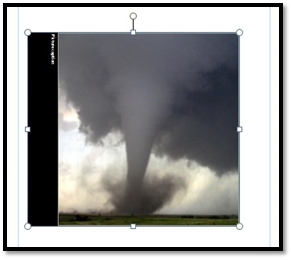Learning to insert pictures and other types of images into your publications will be one of the most important things you learn . Images and graphics are the key to making your publications attractive. However, there are so many methods for inserting images, and so many ways you can alter those images to make them fit in with your presentation, that it's going to take more than one article for us to teach you how to do it successfully.
Any time you want to insert an image into a publication, you'll go to the Insert tab on the ribbon. The Insert tab is pictured below.

You can use the Insert tab to insert all types of things into your publication. For now, though, we're going to focus on pictures and clip art.
There are four methods you can use to insert pictures and clip art into your publications.
1. You can right-click on the image and click copy. You can do this for images you find online, or on your computer. Then, click in your publication and select Paste.
2. You can use pictures you have saved on your computer, external drives, or memory cards (from cameras).
3. You can import pictures you find online using Bing, Facebook, and other sources.
4. Import pictures to the scratch area.
Which method you use will depend on the pictures or clip art you want to use, as well as where the images are located.
We're going to cover methods #2, #3, and #4 in this lesson.
Inserting Images from Your Computer or External Drives
Anytime you want to insert anything into your publication, chances are good you'll find the appropriate button under the Insert tab. The picture tools are grouped in the Illustrations group on the Ribbon.
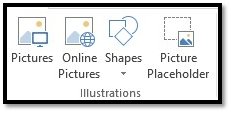
To insert a picture into a publication you have stored on your computer, move the cursor to the place in your publication where you want the picture to appear, then simply click the Picture button. A window will open, allowing you to navigate to the picture on your computer.
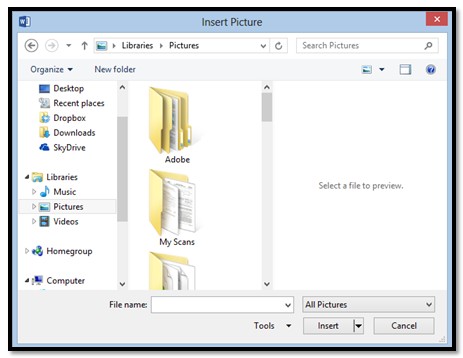
Click the Insert button.
You can then drag and drop the picture to the location where you want it in your publication. You can also resize it and add special effects that we'll cover in the next lesson.
Inserting Online Pictures and Clip art
You can also insert MS Office clip art, images you find using Bing search, and images from your SkyDrive into a publication. To do this, click the Online Pictures button .
When you click the button, this window will appear:
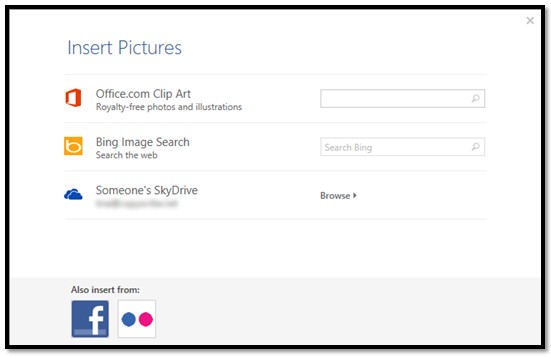
If you want to search for Clip Art, type in a description of what you are looking for. Use keywords, such as coffee, woman, shopping, etc.
We're going to type in coffee.
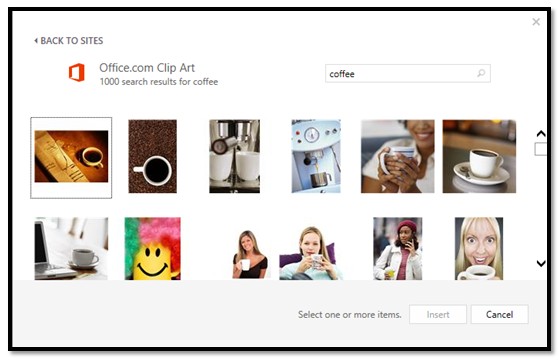
Select the picture you want by clicking on it, then click Insert.
To search for a picture on Bing, then insert it into your publication, type in a keyword just as you did above.
We'll do coffee again.
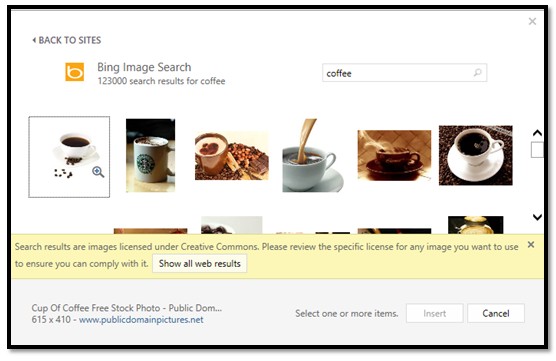
As you can see, Microsoft lets you know that the images shown are licensed under Creative Commons.
As defined by Webopedia:

Make sure you check the copyright to be sure you can use the image. To avoid copyright issues, either use your own images, images that are in the public domain (no copyright), or purchase images from stock photo sites. where you will receive a license with the image.
In addition to inserting pictures from Bing search, you can also insert pictures stored on your SkyDrive.
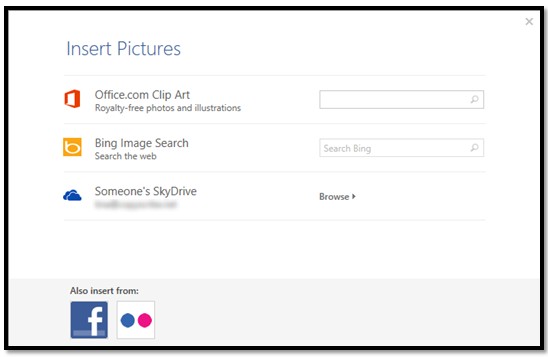
Click Browse.
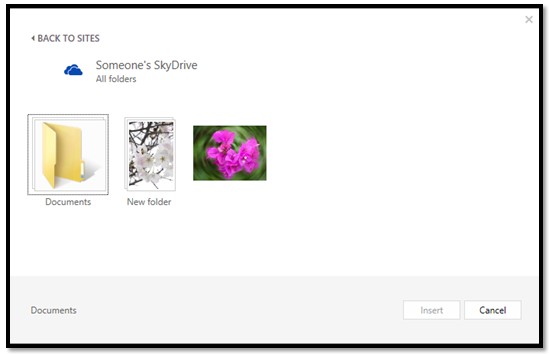
Find the image you want, then click the Insert button.
Insert Images from Facebook and Flickr
To insert images from Facebook or Flickr, click the Online Pictures button again.
For Facebook, click the Facebook icon at the bottom of the window.
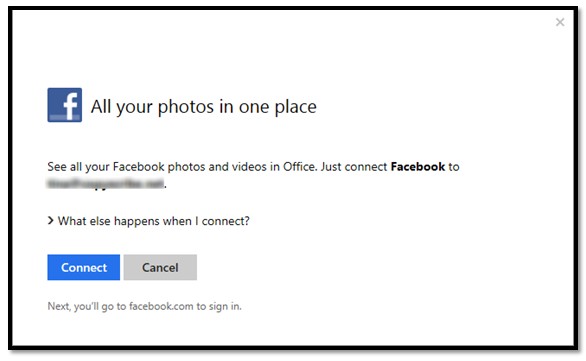
Click Connect.
You'll then be prompted to sign in to your Facebook account:
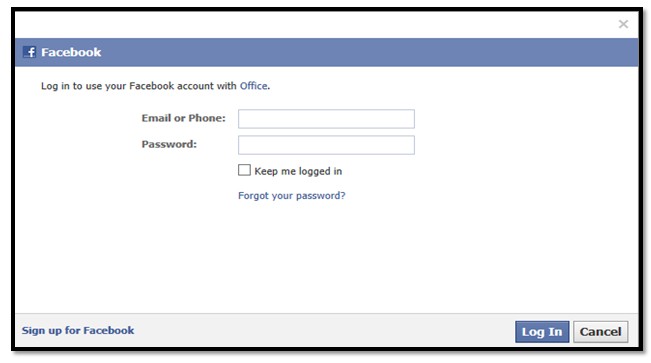
Click Log in. Once you're logged in, you'll see this screen:
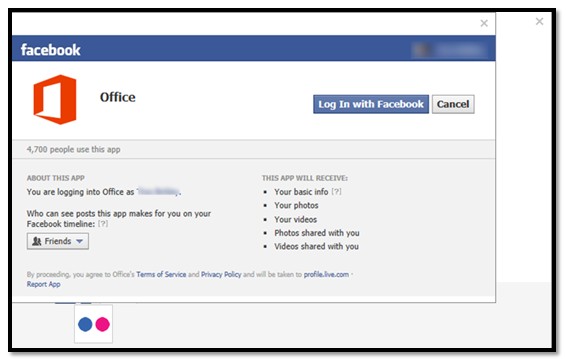
Click Log In with Facebook.
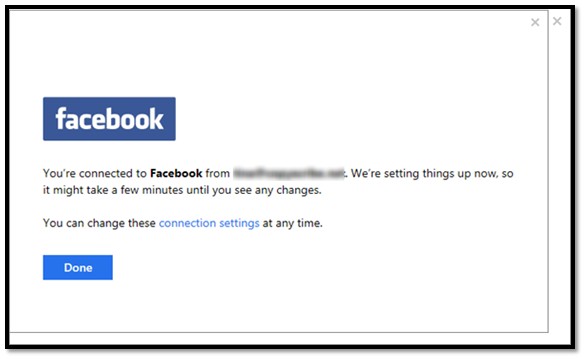
Click Done.
You'll then see Facebook listed with all the other locations where you can search for pictures:
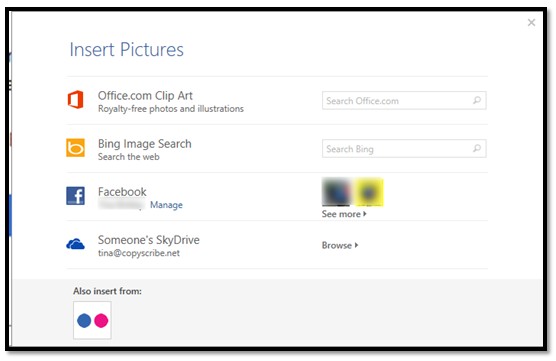
If you want to add pictures from Flickr, click the Flickr button at the bottom to connect to your Flickr account.
Inserting Multiple Pictures Using the Scratch Area
Publisher 2013 gives you the power to insert multiple images into a publication at one time. Instead of inserting one at a time directly into your publication, you can now insert multiple images. Publisher will deposit the multiple images into the scratch area. You can then simply drag and drop images from the scratch area into your publication.
Let's show you how it works.
Go to Pictures under the Insert tab and locate images on your computer, as we've done below.
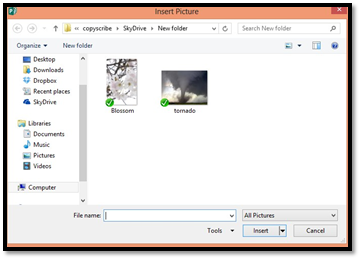
Now, hold down the CTRL key as you select the images you want to use in your publication.
Click the Insert button.
As you can see in the snapshot below, the images now appear in the scratch area to the right of your publication.
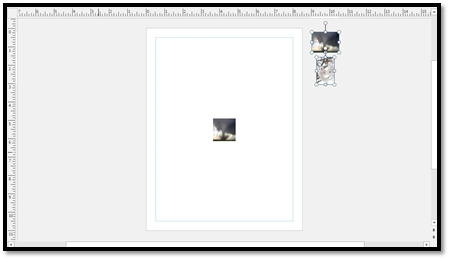
Next, go to the View tab and view the Graphics Manager.
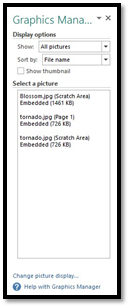
The images in your scratch area are listed here as well.
You can use the Arrange Thumbnails button under the Picture Tools Format tab to arrange images in the scratch area.
Creating a Placeholder for Images
An image placeholder does just as the name implies. It basically reserves space in a publication where an image will be inserted later.
Let's look at an example of how they're used.
Sometimes when you're creating a publication, you may want to design the page layout first. Perhaps you want to create the text boxes (for text) and draw squares where the pictures will be. In other words, you want to get the layout as you want it before you start adding the elements. It's easy enough to draw a text box, then add text later, as you'll learn later.
However, if you just draw a square shape to represent a picture, you'll have to go back later and delete the shape, then insert/format the picture. That's a lot of work! Instead, you can add an image placeholder.
To do this, go to the Insert tab and click the Picture Placeholder button in the Illustrations group.
You'll see a bounding box appear with an image icon in the center of it. The image icon has an illustration of a mountain, as shown below.
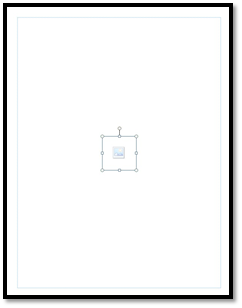
You can drag and drop the placeholder to where you want it to appear in your page layout. You can also double-click on the placeholder to re-size it. Make sure you double-click on the bounding box and not the image icon.
Go to the ribbon. The Picture Tools Format tab will be open. Enter the new dimensions in the Size group.
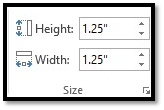
When you're ready to insert a picture, go to the View tab and open the Graphics Manager.
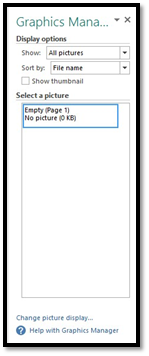
Hover over the placeholder listed in the Graphics Manager. You'll see a downward arrow.
Select Insert Picture Into This Frame.
Find the picture on your computer.
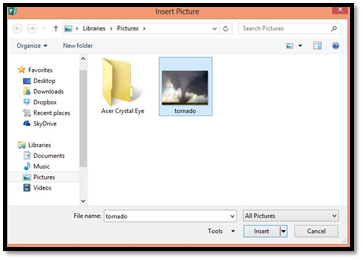
Click the Insert button.
You can then re-size and crop the image, when using the Graphics Manager.
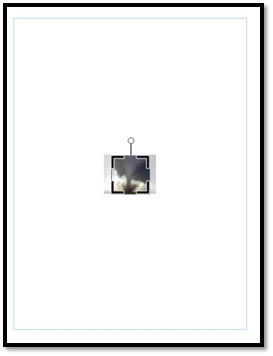
Applying Formatting and Other Corrections to Images
Working With Inserted Images
By far, the easiest way to insert images is by creating placeholders, then inserting them. Here is why. Whenever you insert a picture into a publication using the Pictures button on the ribbon, Publisher just slaps the picture on your publication, as shown below.
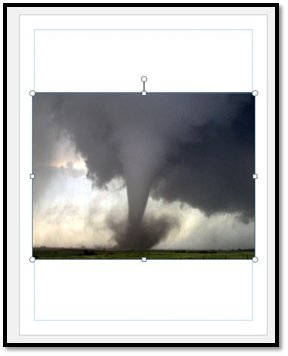
You then have to drag and drop the image to the location where you want it to appear, and also re-size it. It's much easier to just create placeholders, then insert images using the Graphics Manager.
That said, let's talk about how to work with images you insert using the Pictures button.
To move the image, select the image, then move your mouse to the icon displayed on the picture.
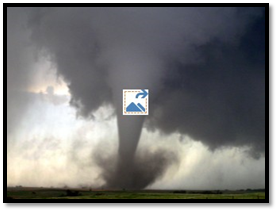
You can then drag the picture to the location where you want it to appear.
You can also right click on the mountain icon.
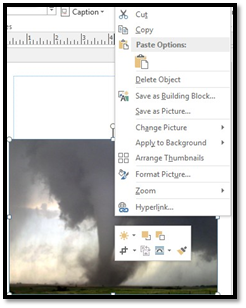
Using the context menu, you can cut, copy, and paste the image, save it as a building block, save it as a picture on your computer, change the picture, apply the picture as the background for your publication, arrange thumbnails, format the picture, zoom in or out on the picture, or add a hyperlink � or a link to a web address.
You can also use the tools in the small box that appears to make color corrections, crop, wrap text, and other things.
Re-size an Image
To re-size an image, start out by selecting it.
When you do, the Picture Tools Format tab will open on the ribbon.
Go to the size group.
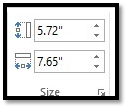
Enter the measurements you want for the picture.
You can also re-size images by dragging the handles on the bounding box.
Crop a Picture
When you crop a picture, you cut away the outer edge of the picture to create a new version.
Let's crop the picture below.
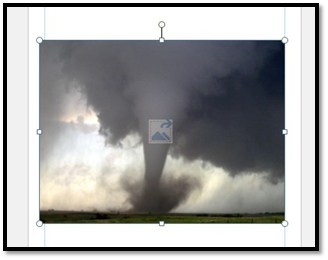
Double-click on the image, then go to Crop under the Picture Tools Format tab, located in the Crop group.
Click the button and select Crop from the drop-down menu.
You'll now see crop marks around your image. These should look familiar to you from an earlier section.
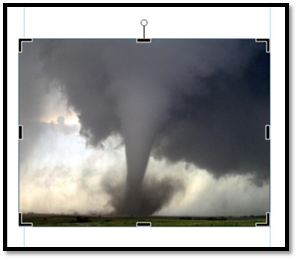
Click and drag your mouse on any of these marks. Click and drag inward on the image until you have cropped away the area you want to get rid of in the image.
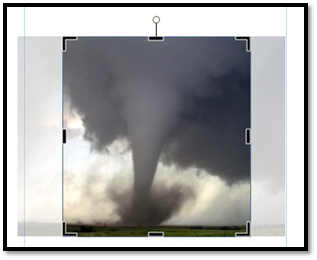
The area you're cropping away is shaded.
Click outside of the image to remove the cropped area.
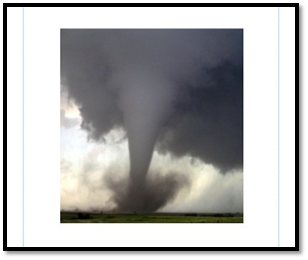
Color
You can easily adjust the color of any image you place in your publications.
To do this, double-click on the image.
You'll then see the Picture Tools Format Tab. Click the Re-color button:
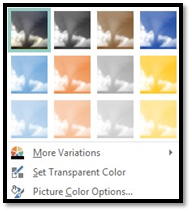
Choose the color effect you want to apply to your image.
Color Correction
You can also adjust and modify the colors in your image through color correction. Once again, go to the Picture Tools Format tab by double clicking your image.
Click the Corrections button.
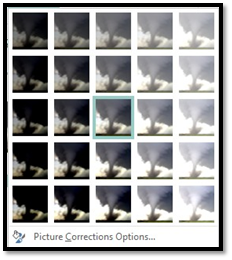
Choose a color correction.
Choose the artistic effect that you want to apply to your image.
Add a Border
It sometimes look nice to add a border to images in your publication. To do this, double-click the image, then go to the Picture Tools Format tab.
Select Picture Border from the Picture Styles group by clicking on the downward arrow.

As you can see, you can choose what color border you want.
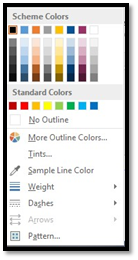
The color you choose is called your outline color.
Add Tint
You can also choose to add a tint to your outline color by selecting Tints from the drop-down menu.
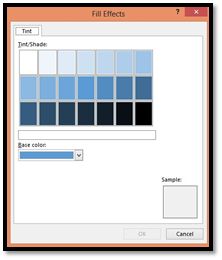
Select the tint you want and click the OK button.
Sample Line Color
You can also use a color that you have in your publication as the border color. For example, let's use our image of the tornado. Let's say we want the color of the sky to be our border color.
Choose Sample Line Color from the drop-down menu.
Your mouse pointer turns into an eyedropper.
Click once on the color you want to use. We're going to click on the sky in our image.
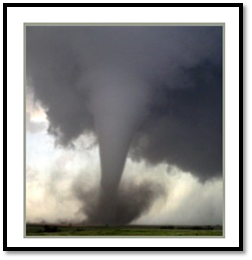
Add Weight, Dashes, and Patterns
Weight refers to the thickness of your border. By clicking Weight in the drop-down menu, you can make your border thicker or thinner. If you choose Dashes from the drop-down menu, you can make the border a dotted line instead of solid.
You can also use a pattern as your border.
Select Pattern from the drop-down menu.
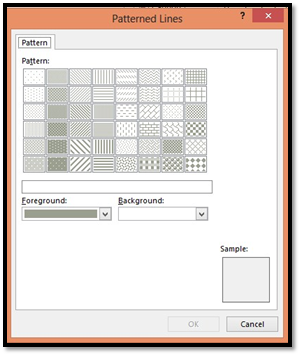
First, select the pattern you want to use from the Pattern section.
Patterns have two colors. The background color, then the color of the actual pattern � or the foreground color.
Select the two colors you want.
Just to give you a better idea of how patterns work, we've selected two colors that will stand out when applied to the border of our image.
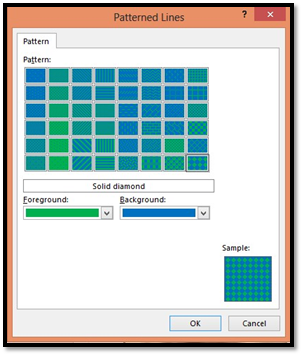
Click OK.
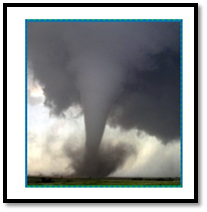
Formatting Clip Art and Pictures Using the Picture Tools and Format Ribbon
Whenever a picture is inserted or selected, the Format tab will automatically appear as a tab in the Ribbon. It provides you with a few of the most commonly used features available in image editing software like Photoshop. You can change the contrast, add artistic effects, remove backgrounds, or crop them. To view the Format tab, select a picture by double-clicking on it.
In the center of this ribbon, you'll see styles you can add to pictures. You can add frames, drop shadows, reflections, etc.

You can also add your own formatting to your images. To add formatting to your picture, you can click the Picture Border, Picture Effects, or Picture Layout, as shown below. These are located in the Picture Styles group under the Format tab.
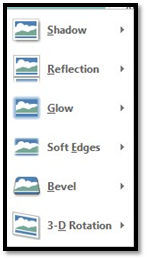
Below, we've added a shadow and a reflection to our image.
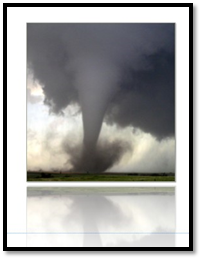
Adding a Caption
When you're creating publications with images and text, it's always helpful to add captions to your images.
Adding captions to your images in Publisher is much easier than doing it in a program such as Word.
Double-click on your image to bring up the Picture Tools Format ribbon.
Click on the drop-down arrow beside Caption in the Picture Styles group.
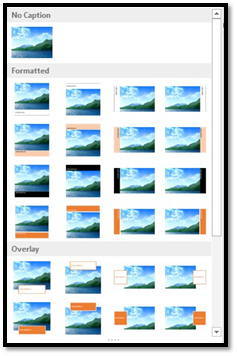
Choose the formatting you want for your caption.
